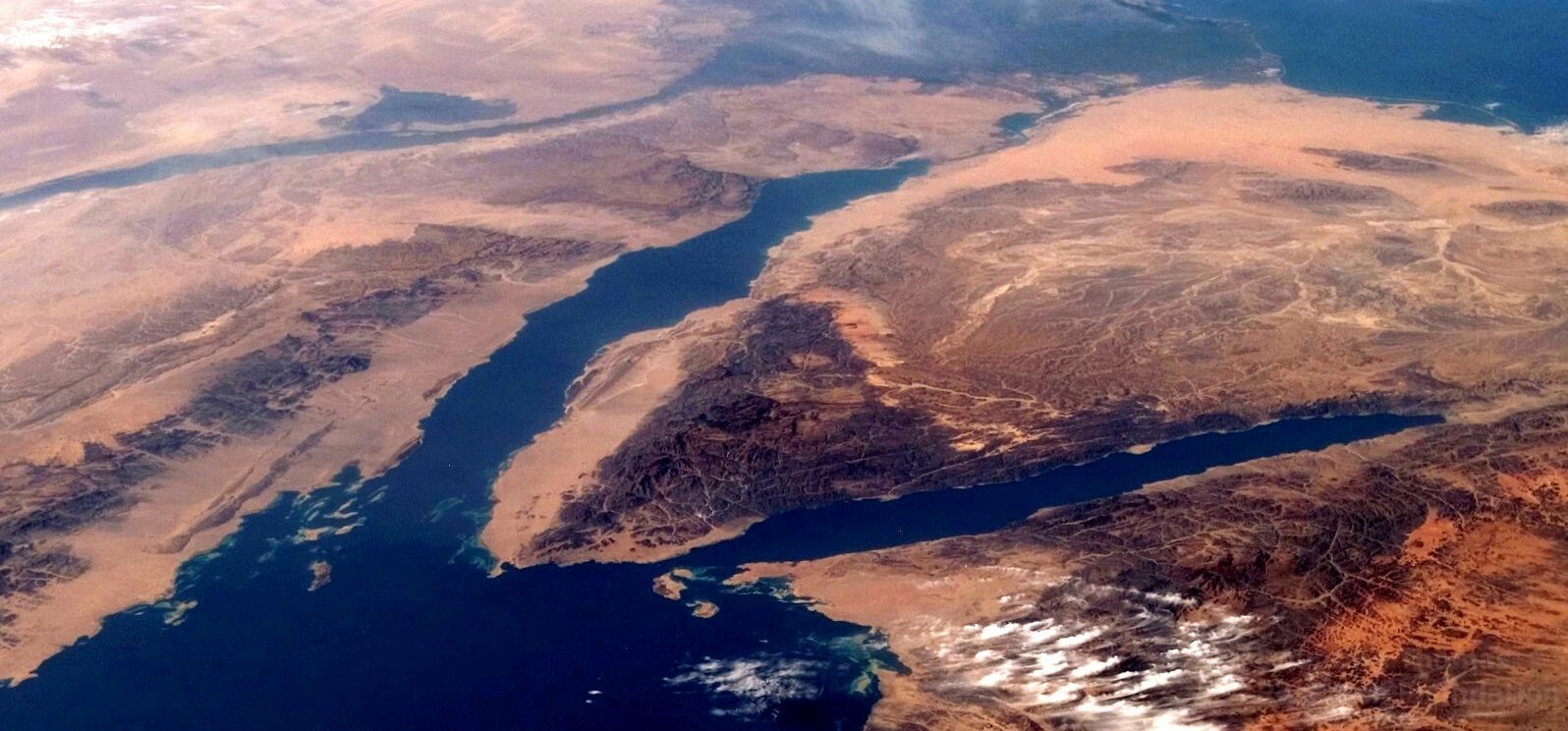Why the Red Sea Crossing Was Not At the Gulf of Suez

A fairly common identification for the Red Sea crossing is at the northern tip of the Gulf of Suez. This position is at least partially rooted in Jewish historian Josephus' account that records the travel time from Egypt to the Red Sea as three days. The alleged implication is that the Red Sea (or, transliterated, Yam Suph) must be very close to the land of Goshen in Egypt.
Many Biblical maps and scholarly articles claim that the Israelites crossed at the northern end of the Gulf of Suez, or further north at the Great Bitter Lake, or even within the Nile Delta. For reasons we detail on our Red Sea crossing page, we explain why neither the Great Bitter Lake nor the Nile Delta theories hold water. Here, we will explore the theory of a Suez crossing, a claim which is held by many traditionalists, but also by some who identify Mount Sinai in Saudi Arabia, such as Rabbi Alexander Hool.
Rabbi Hool identifies Mount Sinai as Jabal Harb in Saudi Arabia, and he believes that the Israelites crossed the Gulf of Suez, not Aqaba. His reasoning is largely based on rabbinic tradition that is supported by few other sources.
In his book Searching for Sinai: The Location of Revelation, he claims that the Israelites traveled from the land of Ramesses and arrived at Etham along the way, which he locates a short distance to the northeast of the tip of the Gulf of Suez. From here, he claims that they turned back, traveled westward, then south to the shores of the Gulf of Suez. He places the location of Pi-Hahiroth in close proximity to Succoth in chapter 8 of this book and concludes that the crossing site must be in this vicinity.
In chapter 11, Rabbi Hool cites rabbinic sources Rambam and Shitah Mekubetzes to conclude that the Israelites traveled into the Red Sea in a semi-circular path, and came back to the shores from which they traveled. From there, they circled back around the top of the Gulf, stopped at Marah, which the Rabbi locates at the Great Bitter Lake, then traveled across the Sinai Peninsula over the top of the Gulf of Aqaba, where they then camped at Elim.
We maintain several objections to the northern Gulf of Suez crossing location.
First, such a long distance between Marah and Elim does not align with the rest of the documentation of the Exodus account. Each campsite from Egypt to Mount Sinai was carefully documented by the author of the book of Exodus and Numbers. Rabbi Hool's distance between Marah and Elim is approximately 270 kilometers in his measurements.
The Israelites greatly slowed down their travels after they crossed the Red Sea. The implicit assumption that there was no documented campsite between Marah and Elim, if separated by 270 km, does not fit with the rest of the narrative.
Another objection is that this crossing site does not appear to be "shut in" by mountainsides as the book of Exodus and Jewish Historian Josephus describe. Josephus clearly states in The Antiquities of the Jews that the mountains surrounded the Israelites on three sides, and ended at the shores of the sea, cutting them off from any route of escape.
Now when the Egyptians had overtaken the Hebrews, they prepared to fight them, and by their multitude they drove them into a narrow place; for the number that pursued after them was six hundred chariots, with fifty thousand horsemen, and two hundred thousand foot-men, all armed. They also seized on the passages by which they imagined the Hebrews might fly, shutting them up between inaccessible precipices and the sea; for there was [on each side] a [ridge of] mountains that terminated at the sea, which were impassable by reason of their roughness, and obstructed their flight; wherefore they there pressed upon the Hebrews with their army, where [the ridges of] the mountains were closed with the sea; which army they placed at the chops of the mountains, that so they might deprive them of any passage into the plain.
Titus Flavius Josephus, The Antiquities of the Jews, Book II, chp. xv.
British-American explorer and scholar Edward Robinson, who is sometimes referred to as the "Father of Biblical Geography," wrote about the differences between the marked differences in the landscapes of the two Gulfs:
The Gulf of Suez, as seen from the adjacent hills, presents the appearance of a long strip of water, setting up like a large river through a desert valley of twenty to thirty miles in width; the shores skirted sometimes by arid plains, and sometimes interrupted by naked mountains and promontories on either side.
The eastern Gulf of the Red Sea is narrower than the western; it is a long blue line of water running up through the midst of a region that is totally desolate. The mountains too are here higher and more picturesque than those that skirt the Gulf of Suez; the valley between them is less broad; and there is not the same extent of wide desert plains along the shores.
E. Robinson and E. Smith, Biblical Researches in Palestine, Mount Sinai, and Arabia Petraea, (Crocker & Brester: Boston, 1841), 69, 229.
At the northern tip of the Gulf of Suez, near the town of Adabiya, there are some mountains near the water, but the mountains do not surround this particular location in the same way as the mountains do at Nuweiba beach at the Gulf of Aqaba. Nuweiba's terrain better fits the historical record.
Our research also indicates that during the time of the Exodus, the Sinai Peninsula was under Egyptian control and was heavily garrisoned to guard the valuable copper and turquoise mines. If the Israelites "crossed" the Red Sea at the northern tip of Suez, and hooked back around to the same shores from which they came, they would not have been out of Egyptian territory, but well within. They still would have had quite a ways to march before they would have been out of Egypt-proper, and an even longer distance before they would have been completely out of Egyptian-controlled territory.
Dr. Glen Fritz also notes that there is little evidence of any interest or activity in or around the northern end of the Gulf of Suez during this time period. In his book The Lost Sea of the Exodus, he notes that there is more evidence of ports further south in the Gulf, but not at the head. Based on the fact that there was so little activity in the region, he concludes that it is unlikely the Egyptians or the Israelites would have been familiar with or held any interest in this area (43).
Additionally, part of the reason why the Gulf of Suez is considered for a crossing candidate appears to be rooted in a long-held misunderstanding of the Gulf of Aqaba. As we detail on our maps page, the Gulf of Aqaba was not really understood geographically until the 19th century due to hazardous sailing conditions and a lack of mapping technology. Because of this misunderstanding, it appears that historians and geographers presumptuously accepted the site at Mt. Catherine in Egypt's Peninsula, unaware of the fact that this location was still within Egypt's domain.
Also of importance are the boundaries of the Promised Land as given to Abraham and Moses. Exodus 23:31 marks the specific territory God promised to the Israelites, and the Red Sea was one of those boundary markers.
I will fix your boundary from the Red Sea [Yam Suph] to the sea of the Philistines, and from the wilderness to the River Euphrates; for I will deliver the inhabitants of the land into your hand, and you will drive them out before you.
It does not follow that Yam Suph was the Gulf of Suez because ancient Israel's territory never extended that far west. The Egyptian peninsula was held and/or heavily influenced by the Egyptian empire. They would not have permitted the newly formed nation of Israel to expand their borders so far westward without a war, and there is no Biblical record of fighting the Egyptians for territory, only the tribes that inhabited Canaan and northward to the Euphrates River.
The only body of water that fits into the territorial parameters given to Moses is the Gulf of Aqaba, upon where Solomon built his fleet at Ezion-Geber. The Suez crossing theory, as well as the Bitter Lakes and Nile Delta theories, appear to rest on the assumption that Mount Sinai must be in the Sinai Peninsula at St. Catherine's. However, a closer look at the Gulf of Aqaba, and the various Biblical passages referring to it (specifically Yam Suph), it becomes clearer that the Gulf of Suez was not a part of the Exodus journey.
For these reasons, we do not believe that Moses and the Israelites crossed the Gulf of Suez. The more fitting theory, based on the geography and the ancient Hebrew language, is that the crossing took place at the eastern arm of the Red Sea, the Gulf of Aqaba.
Last updated July 13, 2019
